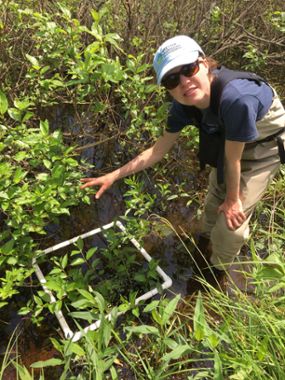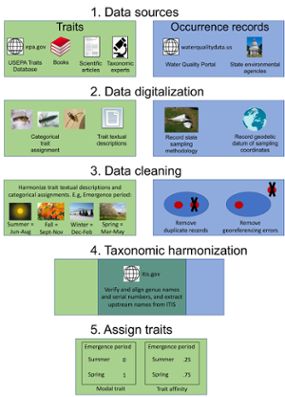MSU scientists conduct largest freshwater insect census in U.S.
When it comes to census taking, people are not the only ones who count.
As the country completes its 2020 Census—the 23rd in U.S. history—researchers in Michigan State University’s College of Natural Science have completed the largest census of freshwater insects ever undertaken in the United States, the first of its kind.

The database includes 2.05 million occurrence records for 932 genera of major freshwater insect orders at more than 51,000 streams and rivers, an endeavor that tripled the number of geographic locations where freshwater insects are observed.
The open-access paper presenting the dataset, “Freshwater insects CONUS: A database of freshwater insect occurrences and traits for the contiguous United States,” was recently published in the journal Global Ecology & Biogeography and was funded by a National Aeronautics and Space Administration (NASA) award and MSU.
“The data for freshwater insects were not available at a continental scale for the United States, even though they were available for other places like Europe,” said co-author Laura Twardochleb, who received her Ph.D. in the Department of Fisheries and Wildlife and Ecology, Evolution and Behavior (EEB) as a member of the Spatial and Community Ecology (SpaCE) Lab at MSU and is now a senior environmental scientist at the California Department of Water Resources.

Freshwater insects, which include beetles, flies, butterflies, moths, lacewings, water bugs and dragonflies, are the primary indicators of water quality and have been monitored in every state since the passage of the federal Clean Water Act in 1972. They are a major source of food for fish, birds, lizards, snakes, bats and spiders.
“Pretty much everything that can will eat them near water bodies,” Twardochleb said.
“This paper fills a major data gap,” said Phoebe Zarnetske, associate professor in the Department of Integrative Biology and EEB, and Principal Investigator of the MSU SpaCE Lab. “These trait and occurrence data will greatly improve the ability to understand and predict patterns of freshwater insect biodiversity because in addition to harmonizing previous databases, we added trait information like feeding style, movement habit, body size and thermal preference for 1,007 stream insect genera.
“An essential part of this research is our data workflow that harmonizes data from disparate sources and includes code and instructions for using the database,” Zarnetske continued. “The data workflow and open-access publication ensure these data follow the FAIR principles of scientific data—findable, accessible, interoperable and reusable.”

The ability to identify and organize species based on traits has come a long way since Darwin sketched finches in the Galapagos in 1835. Today, scientists use powerful genomics tools to identify differences and similarities among species right down to their DNA.
Despite these advances, many states’ data disagreed about species designations, had missing or no data sets at all or collected data differently. But the researchers were not deterred and spent several years contacting state monitoring agencies and collecting publicly available data across the United States.
The monumental task took Zarnetske, Twardochleb and co-authors Ethan Hiltner, now a graduate student at the University of Michigan, and Matthew Pyne, associate professor at Lamar University, almost four years to compile and standardize.
“I am very excited that this paper and dataset consolidate both trait information and insect species occurrence data from many sources into a single expansive dataset,” said Pyne, who compiled traits while a Ph.D. student at Colorado State University. “Our goal is to make North American aquatic insect trait information more comprehensive, similar to European trait data that has been widely available for many years.”

The dataset is a powerful tool for revealing trait distributions, assessing biodiversity patterns, and monitoring the ecological integrity of surface waters on a global scale—major goals of biogeography, community ecology and conservation research.
One of Twardochleb’s key contributions was increasing the number of freshwater insect traits by creating a percentage system like those in Europe known as “fuzzy traits.”
“Until now, the United States assigned only one feeding mode to insects based on what the insect most often ate, but species that most often eat other insects might also eat plants or algae 50 percent of the time and decaying organic matter 3 percent of the time,” Twardochleb explained. “We wanted to account for the other percentages with a scoring system that reflected all three of these things.”
The dataset is now an invaluable tool for researchers in the United States who can utilize the continental-scale information for evolutionary studies and for climate change research, which is what Twardochleb focused on.
_300x214.jpg)
“I wanted to know what watersheds had species that were sensitive to climate change, so I used the dataset as a way to identify species that are indicators of climate change vulnerabilities,” Twardochleb said. “We also wanted to know the location of rare species so that if they exist only in small places in the world, like a rare dragonfly, then we will better know how to protect that species.”
The freshwater insect CONUS is not a dataset-in-stone, and the researchers hope that present gaps will be filled in over time, providing an even more comprehensive picture of freshwater insect biodiversity in the United States and around the world.
To access the publicly available dataset, please visit the NSF-funded Environmental Data Initiative, instrumental in guiding the final database format, that hosts these data: https://doi.org/10.6073/pasta/8238ea9bc15840844b3a023b6b6ed158.
Banner image: The stonefly (Plecoptera) is one order of freshwater insect commonly monitored by state agencies for assessment of water quality. Credit: Dave Huth, Creative Commons Attribution 2.0